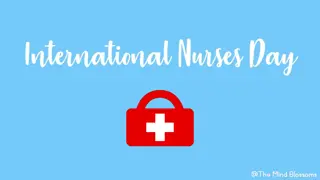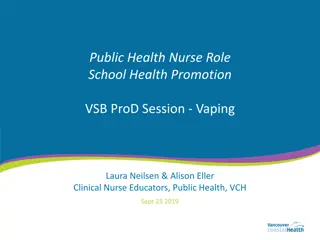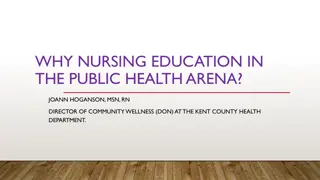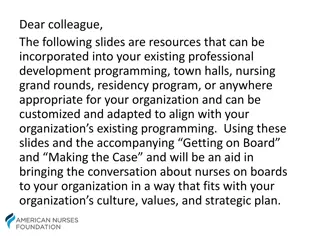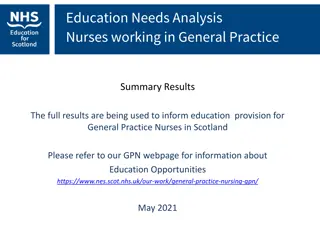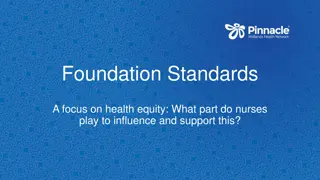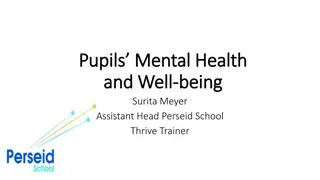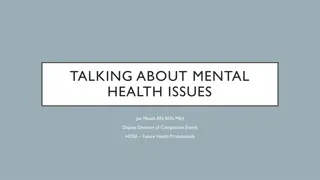The Impact of School Nurses on Mental Health and Academic Outcomes
School nurses play a crucial role in supporting students' mental health, addressing physical and emotional needs, and creating a safe and supportive school environment. They assess and intervene in various situations, from stress-related seizures to abuse cases, and contribute to improved academic performance, teacher focus, attendance rates, and graduation outcomes. By addressing social-emotional needs and promoting mental well-being, school nurses positively impact students' overall success and well-being.
Download Presentation

Please find below an Image/Link to download the presentation.
The content on the website is provided AS IS for your information and personal use only. It may not be sold, licensed, or shared on other websites without obtaining consent from the author. Download presentation by click this link. If you encounter any issues during the download, it is possible that the publisher has removed the file from their server.
E N D
Presentation Transcript
School Nurses Support Mental Health and impact school outcomes Prepared July 2022
School Nurses Support Mental Health School nurses address both physical and social needs (14, 17,32) A student experienced more seizures after a homelife change. The school nurse assessed, identified stressors and emotional responses linked to seizure episodes, and directed accommodations to improve social-emotional support.
School Nurses Support Mental Health Emotions often show up as physical symptoms. Registered nurses assess holistically. (12,30) A student came to the health office with frequent stomachaches and difficulty staying awake in class. The school nurse assessed, identified ongoing abuse, reassured, intervened and helped the student get safe care.
School Nurses Support Mental Health School nurses support school safety and social-emotional climate. (2, 6, 14) The school nurse noted more bullying and poor mental health among students. The nurse boosted school-wide efforts, including suicide prevention trainings and Sources of Strength community-building activities.
School Nurses Support Mental Health School nurses are trusted adults. People confide in them. (12, 17, 26) A student being treated for an injury asked the school nurse, How old is too young to have sex? The school nurse responded therapeutically. The student shared relationship concerns and agreed to further discussion with trusted adults.
School Nurses Support Mental Health About 1/3 of school nurse time is mental health support. (21, 24) A student was fearful after hospitalization for asthma, refusing to participate in activities. The school nurse helped the student learn calming techniques and asthma management, decreasing anxiety and improving socialization.
School Nurses Support Mental Health Positive impacts: Improved academic performance (10, 15, 16, 23) More time for teachers to focus on teaching (13) Lower absenteeism and higher graduation rates (4, 8, 26) and more
Research links school nurses and student success School nurses improve equitable access to education, especially for students experiencing disabilities and students impacted by current and historic disparities. (3, 11) School nurses improve academic achievement, especially for students with chronic conditions. (10, 15, 16, 23) Employing school nurses correlates with increased attendance and higher graduation rates. (4, 8, 26) School nurses support health, safety, and wellbeing in many ways, including: Communicable disease mitigation (1, 31) Increased immunization rates (20) Individualized care planning (10, 28) Medical emergency preparedness (5, 22) Mental health support (6, 14, 24, 30, 32) Registered nurses are more likely to send a student back to class, compared to unlicensed staff. (29) School nurses give teachers and school administrators more time to focus on their primary work. (13) School nurses are essential education partners. (1, 9, 11, 16, 18, 24)
References 1. American Academy of Pediatrics, Council on School Health. (2015) Role of the school nurse in providing school health services. Pediatrics; 2015; 137(6) 2. Ancheta, A. J., Bruzzese, J. M., & Hughes, T. L. (2021). The Impact of Positive School Climate on Suicidality and Mental Health Among LGBTQ Adolescents: A Systematic Review. The Journal of school nursing : the official publication of the National Association of School Nurses, 37(2), 75 86. https://doi.org/10.1177/1059840520970847 3. Basch C. (2011) Healthier students are better learners: high-quality, strategically planned, and effectively coordinated school health programs must be a fundamental mission of schools to help close the achievement gap. The Journal of School Health, 81(10):650-62. 4. Best, N. C., Nichols, A. O., Waller, A. E., Zomorodi, M., Pierre-Louis, B., Oppewal, S., & Travers, D. (2021). Impact of School Nurse Ratios and Health Services on Selected Student Health and Education Outcomes: North Carolina, 2011-2016. The Journal of school health, 91(6), 473 481. https://doi.org/10.1111/josh.13025 5. Bingemann, T. A., Nanda, A., & Russell, A. F. (2021). Pharmacology Update: School Nurse Role and Emergency Medications for Treatment of Anaphylaxis. NASN school nurse (Print),36(5), 264 270. https://doi.org/10.1177/1942602X211021902 6. Bohnenkamp JH, Hoover SA. (2015) Supporting Student Mental Health: the role of the school nurse in coordinated school mental health. Psychology in the Schools. 52(7). 7. Centers for Disease Control (CDC). Whole School, Whole Community, Whole Child. Content source: Division of Adolescent and School Health, National Center for HIV/AIDS, Viral Hepatitis, STD, and TB Prevention. Updated October 2015. Available from: https://www.cdc.gov/healthyyouth/wscc/. 8. Daughtry D, Engelke MK. (2018) Demonstrating the Relationship Between School Nurse Workload and Student Outcomes. The Journal of school nursing : the official publication of the National Association of School Nurses, 34(3):174-81. 9. Dolatowski R, Endsley P, Hiltz C, Johansen A, Maughan E, Minchella L, et al. (2015) School Nurse Workload--Staffing for Safe Care: Position Statement. NASN school nurse (Print), 30(5):290-3. 10.Duncan A, Russlynn A. (2010) Free Appropriate Public Education for Students with Disabilities: Requirements Under Section 504 of The Rehabilitation Act of 1973. U.S. Department of Education Office for Civil Rights, Washington, D.C. Revised August 2010.
11. Egerter S, Braverman P, Sadegh-Nobari T, Grossman-Kahn R, Dekker M. (2011). Education and Health: an examination of the many ways in which education can influence health, including how educational attainment affects health across generations and the social and economic advantages it represents. Robert Wood Johnson Foundation. 12. Harding, L., Davison-Fischer, J., Bekaert, S., & Appleton, J. V. (2019). The role of the school nurse in protecting children and young people from maltreatment: An integrative review of the literature. International journal of nursing studies,92, 60 72. https://doi.org/10.1016/j.ijnurstu.2018.12.017 13. Hill, N. J., & Hollis, M. (2012). Teacher time spent on student health issues and school nurse presence. The Journal of school nursing : the official publication of the National Association of School Nurses, 28(3), 181 186. https://doi.org/10.1177/1059840511429684 14. Kilfoy R. C. (2020). How a School Nurse Can Reduce Student Stress Using Systems-Level Thinking. NASN school nurse (Print),35(6), 332 336. https://doi.org/10.1177/1942602X20960404. 15. Kise, S. S., Hopkins, A., & Burke, S. (2017). Improving School Experiences for Adolescents With Type 1 Diabetes. The Journal of school health, 87(5), 363 375. https://doi.org/10.1111/josh.12507 16. Kocoglu D, Emiroglu ON. (2017). The Impact of Comprehensive School Nursing Services on Students' Academic Performance. Journal of caring sciences, 6(1):5-17. 17. Kvarme LG, Misvaer N, Valla L, Myhre MC, Holen S, Sagatun A. (2019). Bullying in School: Importance of and Challenges Involved in Talking to the School Nurse. Journal of School Nursing. 2019 May 5:1059846649. doi: 10.1177/1059840519846649a 18. Leroy Z, Wallin R, Lee S. (2016). The Role of School Health Services in Addressing the Needs of Students With Chronic Health Conditions: A Systematic Review. The Journal of School Nursing 2016;33(1):64-72. 19. Lowe, A. A., Gerald, J. K., Clemens, C., Gaither, C., & Gerald, L. B. (2022). Medication Administration Practices in United States' Schools: A Systematic Review and Meta-synthesis.The Journal of school nursing : the official publication of the National Association of School Nurses, 38(1), 21 34. https://doi.org/10.1177/10598405211026300 20. Lorick SA, Goldberg L, Zhang F, Birkimer N, Dube N, Hubley T, Tipton M, Basurto-Davila R, Graitcer S, Mills DA. (2015). Factors Associated with uptake of the Influenza A(H1N1)pdm09 monovalent pandemic vaccine in K-12 Public Schools, Maine 2009-2010. Journal of Public Health Management and Practice. 2015 Mar-Apr;21(2):186-95.
21.Markkanen, P., Anttila, M., & Vlimki, M. (2021). Supporting Student's Mental Health: A Cross-Sectional Survey for School Nurses. Children (Basel, Switzerland),8(2), 129. https://doi.org/10.3390/children8020129 22.McCaughey, R. A., McCarthy, A. M., Maughan, E., Hein, M., Perkhounkova, Y., & Kelly, M. W. (2020). Emergency Medication Access and Administration in Schools: A Focus on Epinephrine, Albuterol Inhalers, and Glucagon. The Journal of school nursing : the official publication of the National Association of School Nurses, 1059840520934185. Advance online publication. https://doi.org/10.1177/1059840520934185 23.Mosnaim, G. S., Pappalardo, A. A., Resnick, S. E., Codispoti, C. D., Bandi, S., Nackers, L., Malik, R. N., Vijayaraghavan, V., Lynch, E. B., & Powell, L. H. (2016). Behavioral Interventions to Improve Asthma Outcomes for Adolescents: A Systematic Review. The journal of allergy and clinical immunology. In practice, 4(1), 130 141. https://doi.org/10.1016/j.jaip.2015.09.011 24.National Association of School Nurses. (2021). The Behavioral Health and Wellness of Students[Position Statement].Accessed at https://www.nasn.org/nasn-resources/professional-practice-documents/position-statements/ps-behavioral-health 25.National Association of School Nurses. (2020). Framework for 21st Century School Nursing Practice : Clarifications and updated definitions.NASN School Nurse, 35(4), 225 233. https://doi.org/10.1177/1942602x20928372 26.Oregon Healthy Teens Survey. 2019; Accessed at https://www.oregon.gov/oha/PH/BirthDeathCertificates/Surveys/OregonHealthyTeens/Pages/index.aspx 27.Oregon Administrative Rule (OAR) 591-022-2220. Health Services. Accessed at https://oregon.public.law/rules/oar_581-022-2220 28.Oregon Revised Statutes (ORS) 336.201. Nursing Services Provided by District. Accessed at https://www.oregonlaws.org/ors/336.201 29.Pennington, N., & Delaney, E. (2008). The number of students sent home by school nurses compared to unlicensed personnel. The Journal of school nursing : the official publication of the National Association of School Nurses, 24(5), 290 297. https://doi.org/10.1177/1059840508322382 30.Pestaner, M. C., Tyndall, D. E., & Powell, S. B. (2021). The Role of the School Nurse in Suicide Interventions: An Integrative Review. The Journal of school nursing : the official publication of the National Association of School Nurses, 37(1), 41 50. https://doi.org/10.1177/1059840519889679 31.Rothstein, R., & Olympia, R. P. (2020). School nurses on the front lines of healthcare: The approach to maintaining student health and wellness during COVID 19 school closures. NASN School Nurse, 35, 269 275. 10.1177/1942602X20935612 32.Smith-Fromm, T., & Evans-Agnew, R. A. (2017). Educator Preparedness for Mental Health in Adolescents: Opportunities for School Nurse Leadership. NASN school nurse (Print),32(6), 372 377. https://doi.org/10.1177/1942602X17700145







